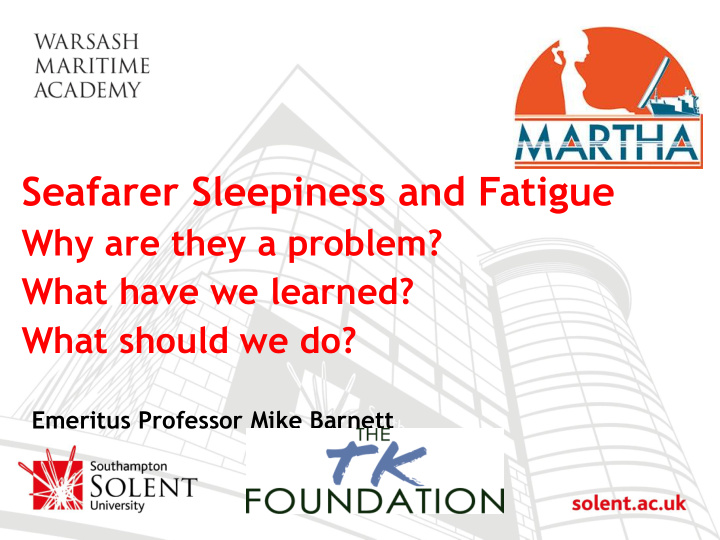



Click to edit Master title style Seafarer Sleepiness and Fatigue Why are they a problem? What have we learned? What should we do? Emeritus Professor Mike Barnett
Click to edit Master title style The Partners: The Stress Research Institute
Click to edit Master title style Distinguishing Sleepiness from Fatigue Longer-term vs Short-term Fatigue Sleepiness May cause health disorders Healthy individuals (physical and mental) Rapid onset Insidious onset Short duration Persists over time Multi-factor causes Single cause Significantly affects Short-term effect on daily behaviour and wellbeing activities 3
Chronic health effects of fatigue Sleeping disorders Insomnia Sleep apnoea/hypopnoea Delayed/advanced sleep phase syndrome Cardiovascular disorders Myocardial infarction Stroke Hypertension Metabolic disorders Metabolic syndrome Hyperlipemia Diabetes Obesity Gastrointestinal disorders Peptic ulcer Source: “ Risk factors for Fatigue in Irritable bowel syndrome seafarers” ( In press: Maritime Common infections Mental disorders Psychology, Springer) Depression Jepsen, J.R., Zhao,Z., Pekcan, C.H. Cancer Barnett, M.L. van Leeuwen, W.. Multiple sclerosis
Competing factors on board that contribute to the adverse health effects of fatigue Nutrition Quality Quantity Soft drinks Sweets Energy expenditure Sedentary work Exercise Smoking
Project ”MARTHA”: Research Design 6
Two European Ship Management Companies: Company “A” Company “B” • 34 Large container • 43 Small tankers ships • NW Europe • Far East – Europe • Intensive trade • Asia – S. America • Ports every 3 days • European officers • European officers • Filipino crew • Filipino crew
Data collected from each vessel: 110 volunteer crew members from two shipping companies • Background questionnaire for each volunteer • Weekly diaries (including KSS and MFI*) for each volunteer • Actiwatch data for two weeks at beginning and end of tour for selected volunteers. • Voyage reports of vessel to cover period of study • Official hours of work/rest for each individual volunteer *KSS = Karolinska Sleepiness Scale MFI = Multidimensional Fatigue Inventory
KSS – The Karolinska Sleepiness Scale 1. extremely alert 2. very alert 3. alert 4. quite alert 5. neither alert nor sleepy 6. some signs of sleepiness 7. sleepy, no effort to stay awake 8. sleepy, some effort to stay awake 9. very sleepy, great effort to keep awake, fighting sleep.
Body Mass Index - BMI 10
Weekly working hours Comp mpan any y B Comp mpan any y A 11
Workload whilst in port B A 12
Circadian type Comp mpan any y B Comp mpan any y A 13
Click to edit Master title style What have we learned? Some results from the analysis of Weekly Diaries and Actigraphy* *With acknowledgements to Dr Anne P Hillstrom and Gemma Hanson of University of Southampton, Centre for Vision and Cognition
Fatigue: is it higher or lower at the end of a voyage? A closer look at the 3 ranks (Third officer, Captain, AB) for which there is the highest number(i.e.: n>10) AB Captain Third Officer 15
Is Stress higher or lower at the end of a voyage? 16
Sleepiness and Fatigue: High levels of sleepiness at all times and increasing fatigue Several other weekly diary items potentially increase with time at sea (including reduced motivation ) 17
Social Cohesion on board
Actigraphy and Amount of Sleep Insert picture here
Example of Actiwatch data: A Bosun on Day work
Actigraphy: Example of a Master – disturbed sleep? Actigraph example of a Master – disturbed sleep?
Amount of Sleep over the Voyage
Average Amount of Sleep by Trade
Average Amount of Sleep by Rank
The effect of voyage time on wake bouts • Significant when anchored at start of contract • Error bars represents 1 sem
A Summary of the MARTHA Findings Recovery periods Sleepiness and Fatigue ? Levels 6 3 Months at Sea
What should we do? Manage the Fatigue Risk. FRMS?
Two Ways to Mitigate the Fatigue Risk: “Hours of rest” – FRMS within the IMO STCW and MLC revised guidelines on fatigue Prescriptive Non-mandatory Negotiated Contract Compliance culture: Goal-based approach minimum standards Scientific basis: data driven Reactive “Best practice”: aspiring to Control excellence Inspection and audit Custom-built to own company using maturity models
Click to edit Master title style Three Core Elements of Fatigue Risk Management 1 Fatigue Awareness training and cultural change programmes; 2 Fatigue reporting system within a just culture; 3 ”Data -driven ” predictive analysis for fatigue risk assessment, workload management and monitoring adequate sleep* • *Tools may include subjective reporting, actigraphy, and fatigue prediction models
Recommend
More recommend